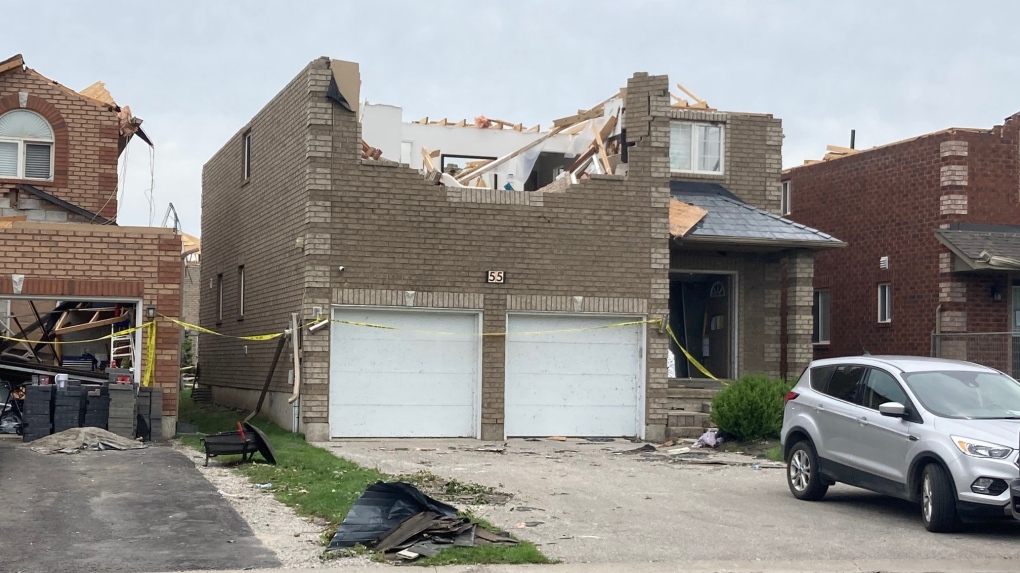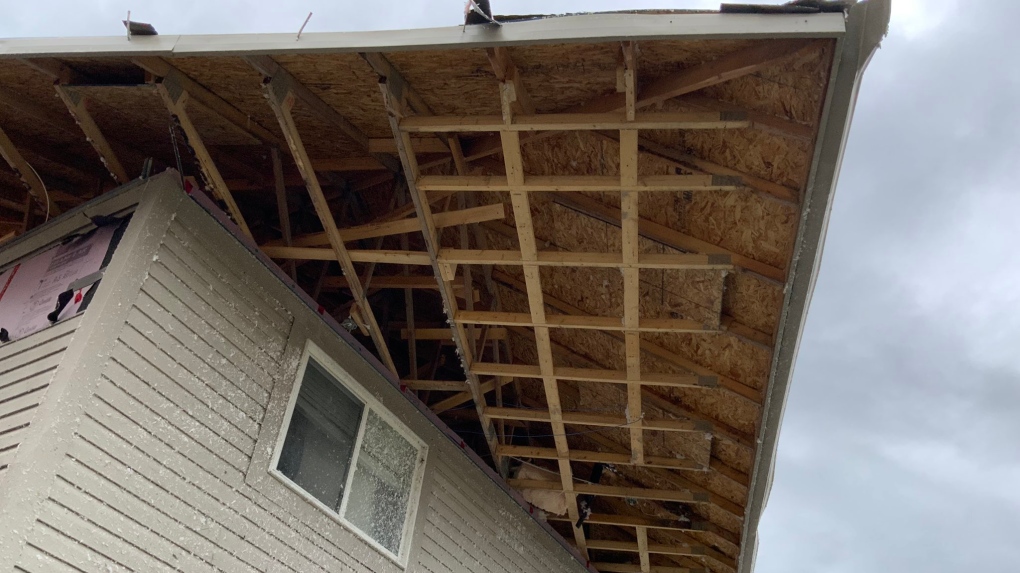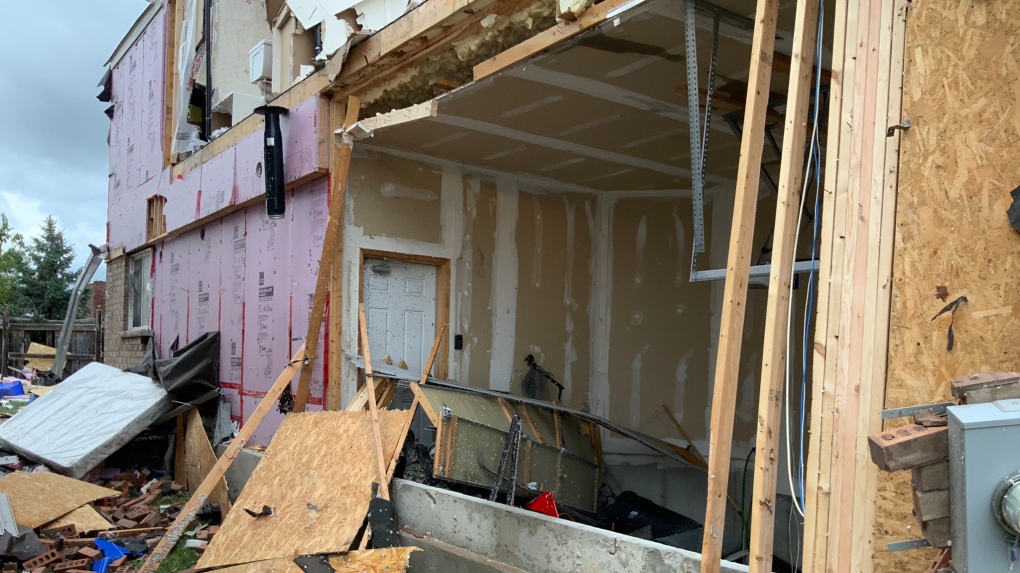Proposed Barrie developments to be built to withstand severe weather
The builder of two proposed developments in Barrie plans to include hurricane straps in its homes following the devastation of last year's tornado.
"It was initially a discussion we had with Counc. Natalie Harris and we brought it back to our construction team, sat down and talked about it and thought it was a good investment for our properties moving forward," said Nicole Sampogna, director of planning and development with StateView Homes.
The move is a first for StateView Homes, which said the small metal bracket would help its builds better withstand severe wind.
"When pressure increases inside the attic, the roof wants to lift," noted Tony Taurasi, StateView Homes' director of construction. "What the clips do is they actually mechanically fasten it to the load-barring walls keeping the structure from lifting up."
The decision follows the aftermath of the twister, which had wind speeds clocking in at 210 kilometres per hour, damaging upwards of 200 homes with roughly 20 roofs ripped away.
The devastation by the EF-2 tornado renewed calls to strengthen Ontario's building code.
"When you have the uplift, you have to hold (the roof) down, and our building code isn't great for that, and we can do a few relatively simple things to improve that," said Gregory Kopp, lead researcher with the Northern Tornadoes Project.
 A damaged home on Sat. July 17, 2021 after an EF-3 tornado passed through Barrie, Ont. (Katelyn Wilson/CTV News)
A damaged home on Sat. July 17, 2021 after an EF-3 tornado passed through Barrie, Ont. (Katelyn Wilson/CTV News)
 Researchers take pictures of damaged homes with "poor construction quality" in Barrie, Ont. following a tornado on July 15, 2021. (Gregory Kopp/Twitter)
Researchers take pictures of damaged homes with "poor construction quality" in Barrie, Ont. following a tornado on July 15, 2021. (Gregory Kopp/Twitter)
In May, the City of Barrie submitted what it calls a robust proposal to the province recommending changes, including hurricane straps and other joints within the wall down to the foundation.
"The hurricane straps are very beneficial for the joint between the roof and the wall, but we can't ignore all the other connections that go into tension," said Michael Janotta, Barrie's chief building official.
"If you think of your wall as being a link system, a chain, there are eight different joints that could fail within that chain, and each of those joints have a different strength. So what we want to do is make sure each link in that chain has enough strength to be able to resist a tornado," he continued.
Janotta said that the code currently deals with how to connect those joints but does not contemplate a house being built to resist that amount of uplift.
"Those joints are designed considering mostly downward loads, rather than upward loads, so when we have a complete load reversal, different things need to happen, and that's why we need to build it different," Janotta said. "Change is difficult, and there is always resistance to change, but I think they see the value in what we're proposing."
 Researchers take pictures of damaged homes with "poor construction quality" in Barrie, Ont. following a tornado on July 15, 2021. (Gregory Kopp/Twitter)
Researchers take pictures of damaged homes with "poor construction quality" in Barrie, Ont. following a tornado on July 15, 2021. (Gregory Kopp/Twitter)
According to the Insurance Bureau of Canada (IBC), across the country, insured losses from natural disasters over the last decade average $2.2 billion a year, far exceeding the average in the previous decade of $632 million.
"The severe weather that we are seeing is not the weather we saw 10 plus years ago, and we have to build our homes and buildings to withstand the types of events that we're seeing," said Anne Marie Thomas, IBC director of consumer and industry relations. "These events are not going away, so we should be making our buildings better."
"The cost of the straps ranges from $1.50 to $5 per strap, plus whatever it costs to do the installation, so it's a very little cost that adds so many benefits to the house. It's very relevant to have them implemented into all our projects now," Taurasi added.
A statement from Nazaneen Baqizada, spokesperson for the Ministry of Municipal Affairs and Housing, noted, "We are actively collaborating with the City of Barrie to complete their code change proposal and have also started engaging with the National Research Council on how the National Construction Codes and Ontario Building Code can be improved with better hurricane and tornado wind impact protection requirements moving forward."
As of now, no clear timeline has been given on when those changes, if any, would happen.
- DETAILS: Stories from the July 15, 2021, Barrie tornado
- PHOTO GALLERY: Destruction from tornado in Barrie community
- WATCH VIDEO: Videos and reports from the 2021 tornado
CTVNews.ca Top Stories

Indian envoy warns of 'big red line,' days after charges laid in Nijjar case
India's envoy to Canada insists relations between the two countries are positive overall, despite what he describes as 'a lot of noise.'
Stormy Daniels describes meeting Trump during occasionally graphic testimony in hush money trial
With Donald Trump sitting just feet away, Stormy Daniels testified Tuesday at the former president's hush money trial about a sexual encounter the porn actor says they had in 2006 that resulted in her being paid to keep silent during the presidential race 10 years later.
U.S. paused bomb shipment to Israel to signal concerns over Rafah invasion, official says
The U.S. paused a shipment of bombs to Israel last week over concerns that Israel was approaching a decision on launching a full-scale assault on the southern Gaza city of Rafah against the wishes of the U.S.
Former homicide detective explains how police will investigate shooting outside Drake's Bridle Path mansion
Footage from dozens of security cameras in the area of Drake’s Bridle Path mansion could be the key to identifying the suspect responsible for shooting and seriously injuring a security guard outside the rapper’s sprawling home early Tuesday morning, a former Toronto homicide detective says.
Northern Ont. woman makes 'eggstraordinary' find
A chicken farmer near Mattawa made an 'eggstraordinary' find Friday morning when she discovered one of her hens laid an egg close to three times the size of an average large chicken egg.
Susan Buckner, who played spirited cheerleader Patty Simcox in 'Grease,' dead at 72
Susan Buckner, best known for playing peppy Rydell High School cheerleader Patty Simcox in the 1978 classic movie musical 'Grease,' has died. She was 72.
Jeremy Skibicki has 'uphill battle' to prove he's not criminally responsible in Winnipeg killings: legal analysts
Accused killer Jeremy Skibicki could have a challenging time convincing a judge that he is not criminally responsible for the deaths of four Indigenous women, a legal analyst says.
Bye-bye bag fee: Calgary repeals single-use bylaw
A Calgary bylaw requiring businesses to charge a minimum bag fee and only provide single-use items when requested has officially been tossed.
Alcohol believed to be a factor in boating incident after 2 men die: N.S. RCMP
Two Nova Scotia men are dead after a boat they were travelling in sank in the Annapolis River in Granville Centre, N.S., on Monday.































